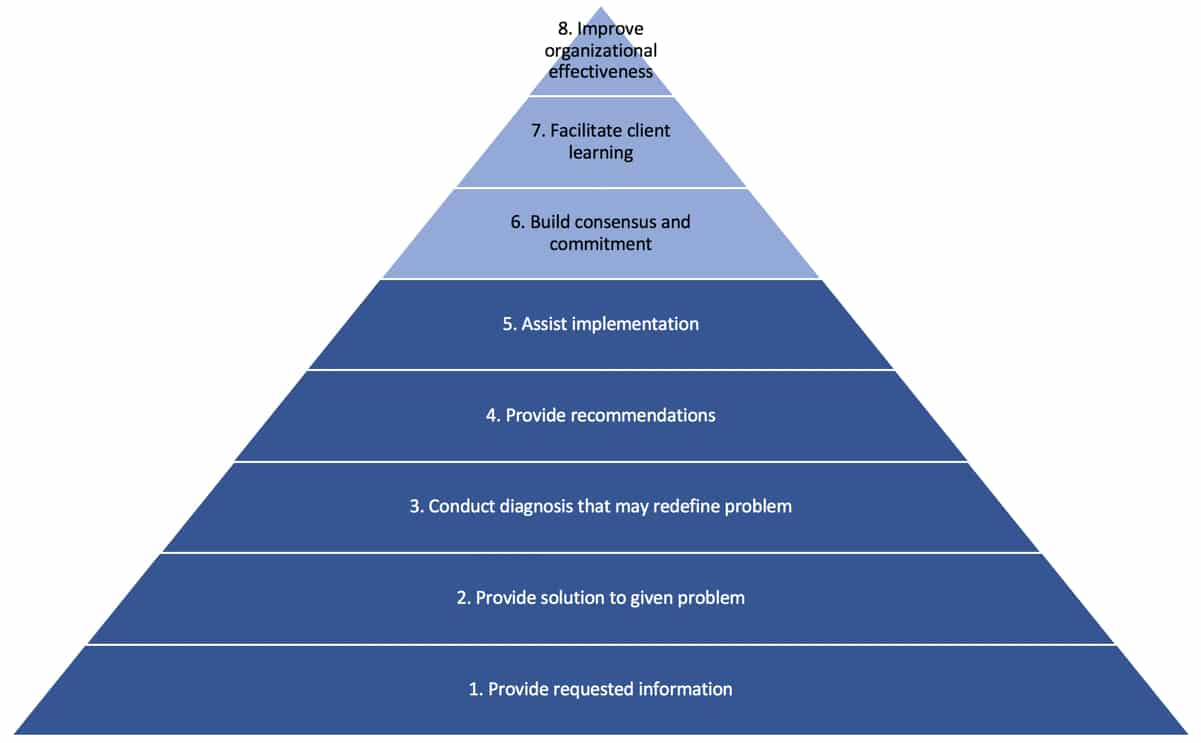Every year strategy consulting firms and agencies that specialise in executive business management and the “maximising shareholder value” approach receive billions of dollars for their services (Management Consulting, 2020).
Are consulting firms about more than just advising management? What else do consultants accomplish for a business?
To understand what value is offered by consultants, we need to know how their services fall into a natural hierarchy.
Hierarchy of Purposes
The hierarchy of purposes is a pyramid that describes and ranks eight consulting purposes. It was designed to clarify the purpose of management consulting. The idea is that if both sides understand the purpose at hand, then they will be more likely to work effectively together (Management Consulting, 2020).
Hierarchy of Consulting Purposes
Source: Harvard Business Review, 1982
The lower purposes (1 to 5) are the ones which are most understood and requested by clients. While the top three tiers (6 to 8) are goals that top consultants strive to achieve and that can help take businesses to the next level (Management Consulting, 2020).
To understand whether consultants do more than merely give “advice” it is important to understand what we mean by “advice” and also the relationship between the eight purposes in the hierarchy.
“Advice” is defined in the Oxford Dictionary as “guidance or recommendations offered with regard to prudent future action” (Lexico, 2020), and “guidance” is defined as “advice or information aimed at resolving a problem or difficulty, especially as given by someone in authority” (Lexico, 2020).
Purpose 1 – 3 are:
- provide requested information
- provide solution to given problem, and
- conduct diagnoses that may redefine problem.
These first three purposes seem to fit the ordinary dictionary meaning of ‘advice’. These purposes tend to be relatively well understood, practiced and requested by clients. But, does it end there? No, because many consultants aspire to fulfil a higher purpose on the pyramid (Turner, 1982).
Purposes 1 through 5 are generally considered legitimate consulting functions. Whereas, purposes 6 through 8 are less likely to be requested by clients. However, that does not mean that these additional goals are not worthwhile. Instead, the goals at the top of the hierarchy tend to be addressed as a by-product of fulfilling purposes 1 through 5, but they are not necessarily dependant on these first five goals being achieved for them to be implemented (Management Consulting, 2020).
The primary goal of consultants is to first address the problems that the client has hired them to resolve. We can see that this explicitly fits within the ordinary meaning of “advice”. If the initial goals established by the client are on track to be achieved and there is a strong working relationship with the client, then top consultants will typically opt to pursue the top three purposes in order to provide more lasting value and improved organisational effectiveness (Management Consultant, 2020). But, if all management consultants strive to reach the top of the hierarchy, are they not then doing more than merely giving ordinary advice?
There may be variance amongst consultants about the consulting goal to be achieved. Should a consultant focus solely on the problems specified by the client, or dig deeper to identify root causes, unmet needs, and to provide additional solutions and recommendations? Will this be in the best interests of the client? Will this be in the consultant’s best interest? At the end of the day, it might be reasonable to expect some variance between the position of an external consultant and an employee.
In striving to achieve the higher-level purposes, consultants will require both professionalism and an increased set of skills in the process of consulting and in managing the client relationship. In order to be more than just a pair of hired hands, consultants need to establish trust, focus on the long-term best interests of the client and not just the immediate need that drove the client to pick up the phone, and have a clear understanding of the client’s goals so that the consultant’s advice not only treats the symptoms but cures the disease and leads to improved organisational effectiveness going forwards.
Celine Smith is a student at Victoria University of Wellington completing a conjoint degree in Law and Commerce. Conducting research for the School of Information Systems, she is invested in obtaining a career that advances information technologies.
Image: Pexels
References
Management Consulting. (2020). Understanding the Hierarchy of Consulting Purposes.
Turner, A. (1982, September). Consulting is more than giving advice.
Consulting Edge. (2019). Hierarchy of Consulting Purposes.
Appelbaum SH, Steed AJ (2005) The critical success factors in the client-consulting relationship.

